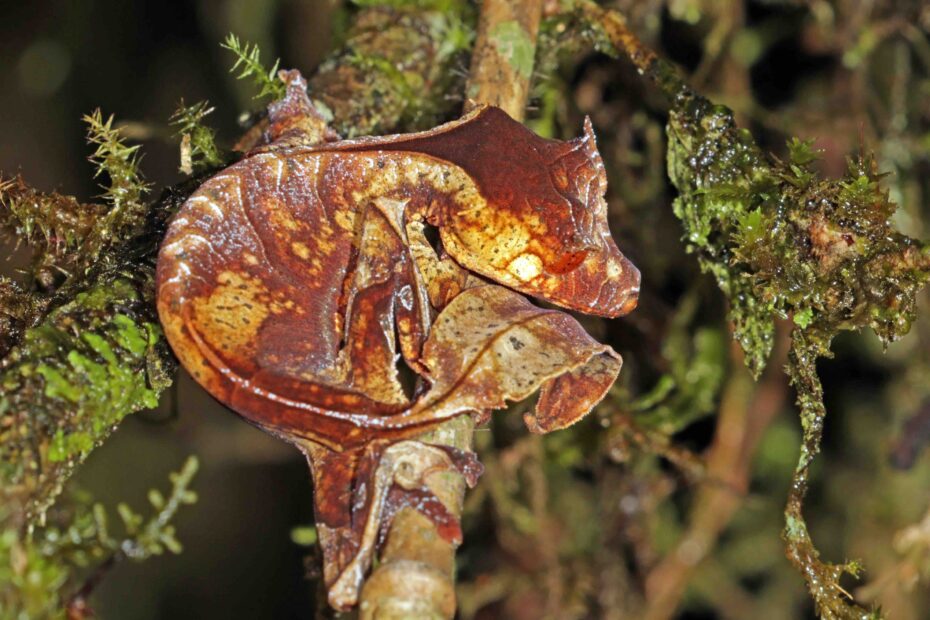In the remarkable world of reptiles, the satanic leaf tailed gecko stands out for its unique appearance and incredible ability to blend into its environment. Let us see what is satanic leaf tailed gecko, uncovering various aspects of its life, habitat, and behavior.
What is Satanic Leaf Tailed Gecko?
The satanic leaf tailed gecko is a species of gecko endemic to the island of Madagascar. Its scientific name, Uroplatus phantasticus, hints at its fantastical appearance. This species is part of the Uroplatus genus, known for their remarkable camouflage abilities. The satanic leaf tailed gecko is relatively small, with an average body length of about 2.5 to 6 inches. It possesses large, lidless eyes with vertical pupils, which enhance its nocturnal vision. Its body is dorsoventrally flattened, aiding in its leaf-like appearance.
The satanic leaf tailed gecko has captured the fascination of people worldwide due to its unique appearance. It is often featured in documentaries and wildlife photography, serving as a symbol of the incredible diversity and beauty of Madagascar’s wildlife.
The satanic leaf tailed gecko is a remarkable creature that showcases the wonders of evolution and adaptation. Its ability to mimic a leaf is unparalleled in the animal kingdom, making it a subject of intrigue and admiration.

Featured image courtesy: www.facebook.com
10 Facts About the Satanic Leaf Tailed Gecko
The satanic leaf tailed gecko, a creature as intriguing as its name suggests, is one of nature’s most remarkable mimics. Found exclusively in Madagascar, this gecko has captured the interest of herpetologists, wildlife enthusiasts, and curious minds globally. Let’s explore fascinating facts about the satanic leaf tailed gecko that you help you learn more about this extraordinary reptile.
1. It’s The Master of Disguise
The satanic leaf tailed gecko is renowned for its incredible ability to mimic a dead leaf. Its flattened body, leaf-shaped tail, and mottled brown and green skin make it almost indistinguishable from actual leaves, a perfect adaptation to evade predators in the wild.
2. It’s Unique Amongst Its Kind
Belonging to the Uroplatus genus, the satanic leaf tailed gecko stands out even among other leaf-tailed geckos. Its distinctive ‘horns’ above the eyes and the absence of a notch in the tail separate it from its relatives, making it unique in appearance.
3. Satanic Leaf Tailed Gecko Habitat: Madagascar’s Rainforests
This gecko is endemic to the rainforests of Madagascar, preferring humid and warm environments. The dense foliage of these forests provides the perfect backdrop for its camouflage skills, highlighting the importance of preserving these habitats.
4. They Have a Nocturnal Lifestyle
The satanic leaf tailed gecko is a creature of the night. Its nocturnal habits are not just for hunting but also for avoiding daytime predators. The cover of darkness provides an added layer of protection and secrecy to its life.
5. They have Adaptations for Survival
Apart from its camouflage, the satanic leaf tailed gecko has several other adaptations for survival. Its large, lidless eyes with vertical pupils enhance its vision in low light, crucial for its nightly activities.
6. Satanic Leaf Tailed Gecko Diet: An Insect Predator
Primarily insectivorous, the satanic leaf tailed gecko feeds on various insects and invertebrates. Its hunting strategy involves patience and precision, often waiting motionless for the right moment to strike.
7. They Have Unique Reproductive Habits
The reproductive process of the satanic leaf tailed gecko involves the female laying eggs, usually two at a time, in a concealed location. This ensures the safety and protection of the offspring until they hatch.
8. They Prefer Communicating in the Dark
Interestingly, the satanic leaf tailed gecko is known to produce various sounds, from barks to grunts. These vocalizations are used for communication, particularly during the breeding season.
9. They Face Huge Conservation Threats
The satanic leaf tailed gecko faces several threats, primarily habitat loss due to deforestation and the illegal pet trade. Conservation efforts are vital in protecting this species and its natural habitat.
10. It’s A Symbol of Madagascar’s Biodiversity
The satanic leaf tailed gecko has become a symbol of the unique biodiversity of Madagascar. Its existence highlights the ecological significance of the island and the need for global efforts in conservation.
The satanic leaf tailed gecko is a marvel of evolution and adaptation. These 10 facts offer a glimpse into the fascinating world of this unique gecko, reminding us of the wonders that lie hidden in nature’s nooks. As we continue to learn about the satanic leaf tailed gecko, it becomes increasingly important to appreciate and protect the natural wonders of our world.
FAQs on Satanic Leaf Tailed Gecko
- What makes the satanic leaf tailed gecko unique in the animal kingdom?
- The satanic leaf tailed gecko is unique for its exceptional ability to mimic a dead leaf, which is unparalleled in the animal kingdom. Its flattened body, leaf-like tail, and coloration allow it to blend seamlessly into the foliage, making it almost invisible to predators and prey.
- Where can one find the satanic leaf tailed gecko?
- The satanic leaf tailed gecko is endemic to Madagascar, primarily found in the island’s rainforests. These specific habitats, with their humid and warm conditions, are crucial for the survival and camouflage skills of this gecko.
- What does the satanic leaf tailed gecko typically eat?
- The diet of the satanic leaf tailed gecko mainly consists of insects and invertebrates. Being nocturnal, it hunts at night, using its stealth and camouflage to catch prey like moths and other small insects.
- How does the satanic leaf tailed gecko protect itself from predators?
- Apart from its camouflage, the satanic leaf tailed gecko uses stillness and its ability to flatten its body against surfaces to avoid detection. If threatened, it can also open its mouth wide to display a startlingly red interior as a deterrent.
- What are the conservation concerns for the satanic leaf tailed gecko?
- The main conservation concerns for the satanic leaf tailed gecko include habitat loss due to deforestation and the illegal pet trade. Protecting its natural habitat in Madagascar is crucial for the species’ survival.
Featured image courtesy: www.en.wikipedia.org
